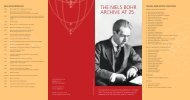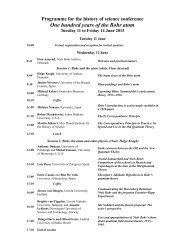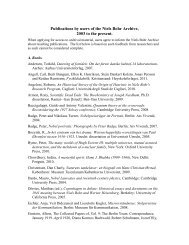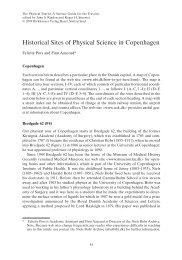Love and physics: Margrethe Nørlund and Niels Bohr's creativity ...
Love and physics: Margrethe Nørlund and Niels Bohr's creativity ...
Love and physics: Margrethe Nørlund and Niels Bohr's creativity ...
Create successful ePaper yourself
Turn your PDF publications into a flip-book with our unique Google optimized e-Paper software.
Shan Gao, University of Sydney, Australia <strong>and</strong> Chinese Academy of Sciences, China<br />
How do electrons move in atoms? ‒ From the Bohr model to quantum mechanics<br />
<strong>Niels</strong> Bohr proposed what is now called the Bohr model of the atom in 1913. He suggested that<br />
electrons are particles <strong>and</strong> they undergo two kinds of motion in atoms; they either move continuously<br />
around the nucleus in certain stationary orbits or discontinuously jump between these orbits. The Bohr<br />
model was latterly replaced by quantum mechanics, in which the physical state of an electron is<br />
described by a wave function. What, then, does the wave function truly represent? Exactly what are<br />
electrons? And how do they move in atoms? In this talk, I will show that a deep analysis of protective<br />
measurements <strong>and</strong> the mass <strong>and</strong> charge distributions of a single quantum system may provide the<br />
answers. It turns out that microscopic particles such as electrons are indeed particles, while their<br />
motion is not continuous but essentially discontinuous <strong>and</strong> r<strong>and</strong>om, displaying wave-like behavior.<br />
Moreover, the wave function represents the state of r<strong>and</strong>om discontinuous motion of particles, <strong>and</strong> in<br />
particular, the modulus square of the wave function gives the objective probability density of the<br />
particles being in certain locations. In some sense, this new picture of quantum reality can be regarded<br />
as a certain extension of Bohr’s discontinuous quantum jumps.<br />
Brigitte Van Tiggelen, Catholic University of Louvain, Belgium, <strong>and</strong> Annette Lykknes, Norwegian<br />
University of Science <strong>and</strong> Technology, Norway<br />
Ida Noddack <strong>and</strong> the fission proposal: the actor’s perspective<br />
The establishment of <strong>Bohr's</strong> atomic model changed the way the Periodic Table of Elements was used,<br />
in particular when it comes to the search <strong>and</strong> the discovery of missing elements, which is the context<br />
within which the discovery of fission took place. When in 1934 Ida Noddack suggested the possibility<br />
that the nucleus might break up into several large fragments during nuclear reactions, she was<br />
commenting Enrico Fermi’s claim of having produced element 93 by bombarding uranium with slow<br />
neutrons. Her criticism <strong>and</strong> suggestion however went unnoticed<br />
The case only resurfaced in history of science several decades later <strong>and</strong> the fact that Ida<br />
Noddack’s proposal was ignored has been interpreted in a wide variety of frameworks: gender, politics,<br />
disciplinary boundaries between chemistry <strong>and</strong> <strong>physics</strong>, authority loss, prematurity in scientific<br />
discovery etc. Some of these interpretations have failed to provide the context <strong>and</strong> the expertise on<br />
which Ida Noddack relied when criticizing the way new elements were allegedly produced, yielding<br />
sometimes anachronistic claims she never made herself. In this paper we draw on previously unused<br />
archival material to provide the actors’ perspective. Among others, we will contrast the views of<br />
Meitner <strong>and</strong> Noddack on matter, the periodic table, <strong>and</strong> the manufacture of missing elements.<br />
13








